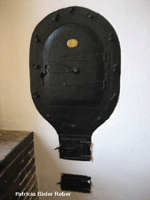





Not all metal ovens are Rumford Roasters. Count Rumford (Benjamin Thompson, 1753-1814) and his Roasters, (first and second picture) are certainly the most well known, but other iron and tin ovens inserted into the side of the hearth were used in Europe and the United States.
Among the variety of metal ovens found in Maryland are Reip's Bake Ovens (third picture). Henry Reip of Baltimore obtained a patent for a Bake Oven and Roaster in 1825. He and his sons manufactured and sold the ovens for about forty years. The oval oven, above, was made by Alfred Reip.
So how were they heated? Rumford and Reip ovens both have a firebox directly under the oven where charcoal or mined coal were burned. The ashes fell into the second, lower box. Thus the heat could be maintained after the food was put on the shelves in the oven to bake. Most metal ovens, including Reip, had a hole over the firebox so the air flowed around the oven and exited out a flue. Generally Rumford Roasters had two pipes where the air was drawn in, heated,then entered the inside of the oven. Both ovens had an upper flue, when opened, allowed the heat from inside the oven to exit.
Brick bake ovens are heated by burning wood for several hours, removing all the burned wood coals, then just using the heat from the bricks to bake the food. The heat decreases since the burning wood is gone. The oven, pictured below, takes me about 2 1/2 hours to get up to baking temperature.

Most existing metal ovens are in private homes, however a few museums, such as Rundlet-May House (Portsmouth, NH) and Hamption NHS (north of Baltimore, MD) have Rumford Roasters or Reip Ovens.
If you know of any type of iron oven (or stew stove, set kettle, boiler, oven...) please contact me at patreber@hearthcook.com
